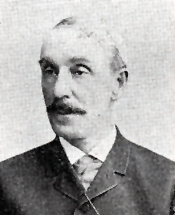George D. Wise facts for kids
Quick facts for kids
George Douglas Wise
|
|
|---|---|
 |
|
| Member of the U.S. House of Representatives from Virginia's 3rd district |
|
| In office March 4, 1891 – March 3, 1895 |
|
| Preceded by | Edmund Waddill, Jr. |
| Succeeded by | Tazewell Ellett |
| In office March 4, 1881 – April 10, 1890 |
|
| Preceded by | Joseph E. Johnston |
| Succeeded by | Edmund Waddill, Jr. |
| Chairman of the House Committee on Interstate and Foreign Commerce | |
| In office March 28, 1892 – March 3, 1895 |
|
| Preceded by | Roger Quarles Mills |
| Succeeded by | William Peters Hepburn |
| Chairman of the House Committee on Manufactures | |
| In office March 4, 1887 – March 3, 1889 |
|
| Preceded by | John Holroyd Bagley, Jr. |
| Succeeded by | Henry Bacon |
| Personal details | |
| Born | June 4, 1831 Deep Creek, Accomack County, Virginia |
| Died | February 4, 1908 (aged 76) Richmond, Virginia |
| Resting place | Hollywood Cemetery, Richmond, Virginia |
| Political party | Democratic |
| Alma mater | Indiana University College of William and Mary |
| Profession | lawyer |
| Military service | |
| Allegiance | |
| Branch/service | |
| Rank | |
| Battles/wars | American Civil War |
George Douglas Wise (born June 4, 1831 – died February 4, 1908) was an important American politician. He served as a U.S. Representative for the state of Virginia. This means he was elected to represent Virginia in the U.S. Congress, which is where laws are made for the country. He was also related to other well-known people in politics, including his cousins John Sergeant Wise and Richard Alsop Wise, and his uncle Henry Alexander Wise.
Contents
Biography: Early Life and Career
George Douglas Wise was born on June 4, 1831, at a place called "Deep Creek" in Accomack County, Virginia. This area is near the town of Onancock, Virginia. His parents were Tully Robinson and Margaret Douglas Pettitt Wise.
He went to Indiana University in Bloomington for his college education. After that, he studied law at the College of William and Mary in Williamsburg, Virginia. Once he finished his studies, he became a lawyer and started his own law practice in Richmond, Virginia.
During the Civil War, George Douglas Wise served as a captain in the Confederate States Army. After the war, he became the Commonwealth's attorney for the city of Richmond. This job meant he was like a chief prosecutor, representing the state in legal cases for the city. He held this position from 1870 until 1889, when he decided to leave.
Serving in Congress
George Douglas Wise was a member of the Democratic Party. He was first elected to the United States House of Representatives in 1880. He served several terms in Congress, from March 4, 1881, to March 3, 1889.
While in Congress, he took on important leadership roles. He was the chairman of the Committee on Manufactures. This committee worked on laws related to factories and making goods in the country. He also became chairman of the Committee on Interstate and Foreign Commerce, which dealt with laws about trade between different states and with other countries.
In 1888, he was re-elected, but the results of his election were challenged by another politician, Edmund Waddill, Jr. After a review, Waddill, Jr. was given the seat instead of Wise on April 10, 1890. However, George Douglas Wise was elected again in 1890 and 1892, serving two more terms from March 4, 1891, to March 3, 1895.
Later Years and Legacy
After his time in Congress, George Douglas Wise continued to be involved in public service. He was chosen as a delegate to the Virginia Constitutional Convention held from 1901 to 1902. This was a special meeting where leaders from Virginia worked together to write new rules and laws for the state's constitution.
George Douglas Wise passed away in Richmond, Virginia, on February 4, 1908. He was buried in Hollywood Cemetery in Richmond.
Electoral History: How He Won Elections
George Douglas Wise was elected to the U.S. House of Representatives multiple times. Here's a look at some of his election results:
- In 1880, he won his first election with more than half of the votes.
- He was re-elected in 1882, 1884, and 1886, each time winning against his opponents.
- In 1888, he won the election, but the results were later changed, and another candidate took his place.
- He was elected again in 1890 without anyone running against him.
- Finally, in 1892, he was re-elected with a large majority of the votes.

